Investigation on the Rheological Properties and Microscopic Characteristics of Graphene and SBR Composite Modified Asphalt
Abstract
1. Introduction
2. Materials and Methods
2.1. Materials
2.1.1. Asphalt
2.1.2. Styrene-Butadiene Rubber (SBR)
2.1.3. Graphene (GR)
2.2. Preparation Methods
Asphalt Modification Procedure
2.3. Test Methods
2.3.1. Routine Performance Test of Asphalt
2.3.2. Storage Stability Analysis of Asphalt
2.3.3. Dynamic Shear Rheometer Test
2.3.4. Bending Beam Creep Test at Low Temperatures
2.3.5. Infrared Spectrum Test
2.3.6. Fluorescence Microscope
3. Results and Discussion
3.1. Conventional Performance Test
3.1.1. Analysis of Basic Physical Properties of GR/SBR Modified Asphalt
3.1.2. Storage Stability Analysis of GR/SBR Modified Asphalt
3.2. Rheological Properties of GR/SBR Modified Asphalt
3.2.1. Temperature Scanning Test and Analysis
3.2.2. Multiple Stress Creep Recovery Test Analysis
3.3. Low-Temperature Cracking Performance of GR/SBR Modified Asphalt
3.4. Study on Modification Mechanism of Graphene
3.4.1. Fourier Infrared Spectrum
3.4.2. Fluorescence Microscope Images and Compatibility Analysis
3.5. Optimization of GR/SBR Composite Asphalt
3.5.1. Evaluation Index Optimization of Modified Asphalt
3.5.2. Modified Asphalt Evaluation Index Scoring Criteria
3.5.3. Weight Determination Based on Comparison Matrix Method
3.5.4. Weight Consistency Test of Judgment Matrix
3.5.5. Asphalt Comprehensive Performance Index Calculation
4. Conclusions
Author Contributions
Funding
Institutional Review Board Statement
Informed Consent Statement
Data Availability Statement
Conflicts of Interest
References
- García-Morales, M.; Partal, P.; Navarro, F.; Martinez-Boza, F.; Gallegos, C.; González, N.; Muñoz, M. Viscous properties and microstructure of recycled eva modifified bitumen. Fuel 2004, 83, 31–38. [Google Scholar] [CrossRef]
- Han, M.Z.; Muhammad, Y.; Wei, Y.; Zhu, Z.; Huang, J.; Li, J. A review on the development and application of graphene based materials for the fabrication of modified asphalt and cement. Constr. Build. Mater. 2021, 285, 122885. [Google Scholar] [CrossRef]
- Xie, J.; Yang, Y.; Lv, S.; Peng, X.; Zhang, Y. Investigation on Preparation Process and Storage Stability of Modified Asphalt Binder by Grafting Activated Crumb Rubber. Materials 2019, 12, 2014. [Google Scholar] [CrossRef]
- Cong, P.L.; Zhang, Y.H.; Liu, N. Investigation of the properties of asphalt mixtures incorporating reclaimed SBS modified asphalt pavement. Constr. Build. Mater. 2016, 113, 334–340. [Google Scholar] [CrossRef]
- Sun, P.; Han, S.; Zhang, H.; Wang, Z. High-temperature Performance of Nano-CaCO_3/SBR Modified Asphalt and Mixture. Mater. Rev. 2016, 30, 122–126. [Google Scholar]
- Liang, P.; Liang, M.; Fan, W.; Zhang, Y.; Qian, C.; Ren, S. Improving thermo-rheological behavior and compatibility of SBR modified asphalt by addition of polyphosphoric acid (PPA). Constr. Build. Mater. 2017, 139, 183–192. [Google Scholar] [CrossRef]
- Liu, K.F.; Zhang, K.; Shi, X.M. Performance evaluation and modification mechanism analysis of asphalt binders modified by graphene oxide. Constr. Build. Mater. 2018, 163, 880–889. [Google Scholar] [CrossRef]
- Lu, Y.; Shi, N.; Wang, M.; Wang, X.; Yin, L.; Xu, Q.; Zhao, P. Research on the Preparation of Graphene Quantum Dots/SBS Composite-Modified Asphalt and Its Application Performance. Coatings 2022, 12, 515. [Google Scholar] [CrossRef]
- Hossain, Z.; Zaman, M.; Saha, M.C.; Hawa, T. Evaluation of Viscosity and Rutting Properties of Nanoclay-Modified Asphalt Binders. In Proceedings of the Geo-Congress 2014 Technical Papers; American Society of Civil Engineers: Reston, VA, USA, 2014; pp. 3695–3702. [Google Scholar]
- Yang, J.; Tighe, S. A Review of Advances of Nanotechnology in Asphalt Mixtures. Procedia Soc. Behav. Sci. 2013, 96, 1269–1276. [Google Scholar] [CrossRef]
- Brcic, H. Investigation of the Rheological Properties of Asphalt Binder Containing Graphene Nanoplatelets; Department of Civil ad Transport Engineering, NTNU: Trondheim, Norway, 2016; pp. 14–28. [Google Scholar]
- Li, Y.Y.; Wu, S.P.; Amirkhanian, S. Investigation of the graphene oxide and asphalt interaction and its effect on asphalt pavement performance. Constr. Build. Mater. 2018, 165, 572–584. [Google Scholar] [CrossRef]
- Zhong, Y.J.; Zhu, H.W. Structure, properties and potential applications of graphene. Physics 2018, 47, 704–714. (In Chinese) [Google Scholar]
- Li, L.W.; Zheng, Q.F.; Dong, S.F.; Wang, X.Y.; Han, B.G. The reinforcing effects and mechanisms of multi-layer graphenes on mechanical properties of reactive powder concrete. Constr. Build. Mater. 2020, 251, 118995. [Google Scholar] [CrossRef]
- Zhao, Y.J.; Liu, Y.M.; Shi, T.; Gu, Y.; Zheng, B.M.; Zhang, K.; Xu, J.H.; Fu, Y.Y.; Shi, S.C. Study of mechanical properties and early-stage deformation properties of graphene-modified cement-based materials. Constr. Build. Mater. 2020, 257, 119498. [Google Scholar] [CrossRef]
- Young, R.J.; Kinloch, I.A.; Gong, L.; Novoselov, K.S. The mechanics of graphene nanocomposites: A review. Compos. Sci. Technol. 2012, 72, 1459–1476. [Google Scholar] [CrossRef]
- He, J.; Hu, W.; Xiao, R.; Wang, Y.; Polaczyk, P.; Huang, B. A review on Graphene/GNPs/GO modified asphalt. Constr. Build. Mater. 2022, 330, 127222. [Google Scholar] [CrossRef]
- Liu, Z.; Tu, Z.; Li, Y.; Yang, F.; Han, S.; Yang, W.; Zhang, L.; Wang, G.; Xu, C.; Gao, J. Synthesis of three-dimensional graphene from petroleum asphalt by chemical vapor deposition. Mater. Lett. 2014, 122, 285–288. [Google Scholar] [CrossRef]
- Zhou, X.; Zhang, X.; Xu, S.; Wu, S.; Liu, Q.; Fan, Z. Evaluation of thermo-mechanical properties of graphene/carbon-nanotubes modified asphalt with molecular simulation. Mol. Simul. 2017, 43, 312–319. [Google Scholar] [CrossRef]
- Huang, W.R.; Yang, Y.Z.; Song, P. Study on electrothermal property of rGo-CF conductive asphalt concrete. New Chem. Mater. 2021, 49, 269–273. [Google Scholar]
- Yhuang, X.Y.; Zhang, W.F.; Cao, P.L. Study on electrical and snow melting and ice melting properties of graphene/graphene oxide modified mortar. Funct. Mater. 2021, 52, 12100–12110. (In Chinese) [Google Scholar]
- Moreno-Navarro, F.; Sol-Sánchez, M.; Gámiz, F.; Rubio-Gámez, M. Mechanical and thermal properties of graphene modified asphalt binders. Constr. Build. Mater. 2018, 180, 265–274. [Google Scholar] [CrossRef]
- Li, B. Rheological Properties of Graphene/Polyethylene Composite Modified Asphalt Binder. Bull. Chin. Ceram. Soc. 2021, 40, 2461–2468. [Google Scholar]
- Yao, H.; Dai, Q.; You, Z.; Ye, M.; Yap, Y.K. Rheological properties, low-temperature cracking resistance, and optical performance of exfoliated graphite nanoplatelets modified asphalt binder. Constr. Build. Mater. 2016, 113, 988–996. [Google Scholar] [CrossRef]
- JTGE 20-2011; Standard Test Methods of Bitumen and Bituminous Mixtures for Highway Engineering. Ministry of Transport: Beijing, China, 2011.
- AASHTO Designation: TP 70-11; Multiple Stress Creep Recovery (MSCR) Test of Asphalt Binder Using a Dynamic Shear Rheometer. AASHTO: Washington, DC, USA, 2011.
- Alghrafy, Y.M.; Alla, E.-S.M.A.; El-Badawy, S.M. Rheological properties and aging performance of sulfur extended asphalt modified with recycled polyethylene waste. Constr. Build. Mater. 2021, 273, 121771. [Google Scholar] [CrossRef]
- Nagabhushanarao, S.S.; Vijayakumar, A.S. Chemical and rheological characteristics of accelerate aged asphalt binders using rolling thin film oven. Constr. Build. Mater. 2021, 272, 121995. [Google Scholar] [CrossRef]
- Liu, K.; Zhu, J.; Zhang, X.; Li, Q.; Wu, C. Performance Evaluation of graphene oxide modified asphalt and pavement performance of OGFC mixtures. J. Chang. Univ. (Nat. Sci. Ed.) 2020, 40, 40–48. [Google Scholar]
- Jiang, W.; Hao, P.; Zhao, Z.; Wu, T.; Li, D. Effect of PVP Modified Graphene on Rheological Properties of SBS Modified Asphalt. J. Build. Mater. 2021, 24, 385–392. [Google Scholar]
- Zhu, J.; Li, Q.; Liu, K. Properties of graphene oxide modified asphalt binder. China Powder Sci. Technol. 2018, 24, 70–76. [Google Scholar]
- ASTM D7643-10; Standard Practice for Determining the Continuous Grading Temperatures and Continuous Grades for PG Graded Asphalt Binders. ASTM: West Conshohocken, PA, USA, 2010.
- Tan, Y.Q.; Fu, Y.K.; Ji, L.; Zhang, L. Low temperature evaluation index of rubber asphalt. J. Harbin Inst. Technol. 2016, 48, 66–70. [Google Scholar]
- Nie, Y.; Sun, S.; Ou, Y.; Zhou, C.; Mao, K. Experimental Investigation on Asphalt Binders Ageing Behavior and Rejuvenating Feasibility in Multicycle Repeated Ageing and Recycling. Adv. Mater. Sci. Eng. 2018, 2018, 5129260. [Google Scholar] [CrossRef]
- Yadykova, A.Y.; Strelets, L.A.; Ilyin, S.O. Infrared Spectral Classification of Natural Bitumens for Their Rheological and Thermophysical Characterization. Molecules 2023, 28, 2065. [Google Scholar] [CrossRef]
- Duan, Z.Y. Research on the Comprehensive Performance Analysis and the Preferred Method of Asphalt. Master’s Thesis, Chang’an University, Xi’an, China, 2015. [Google Scholar]
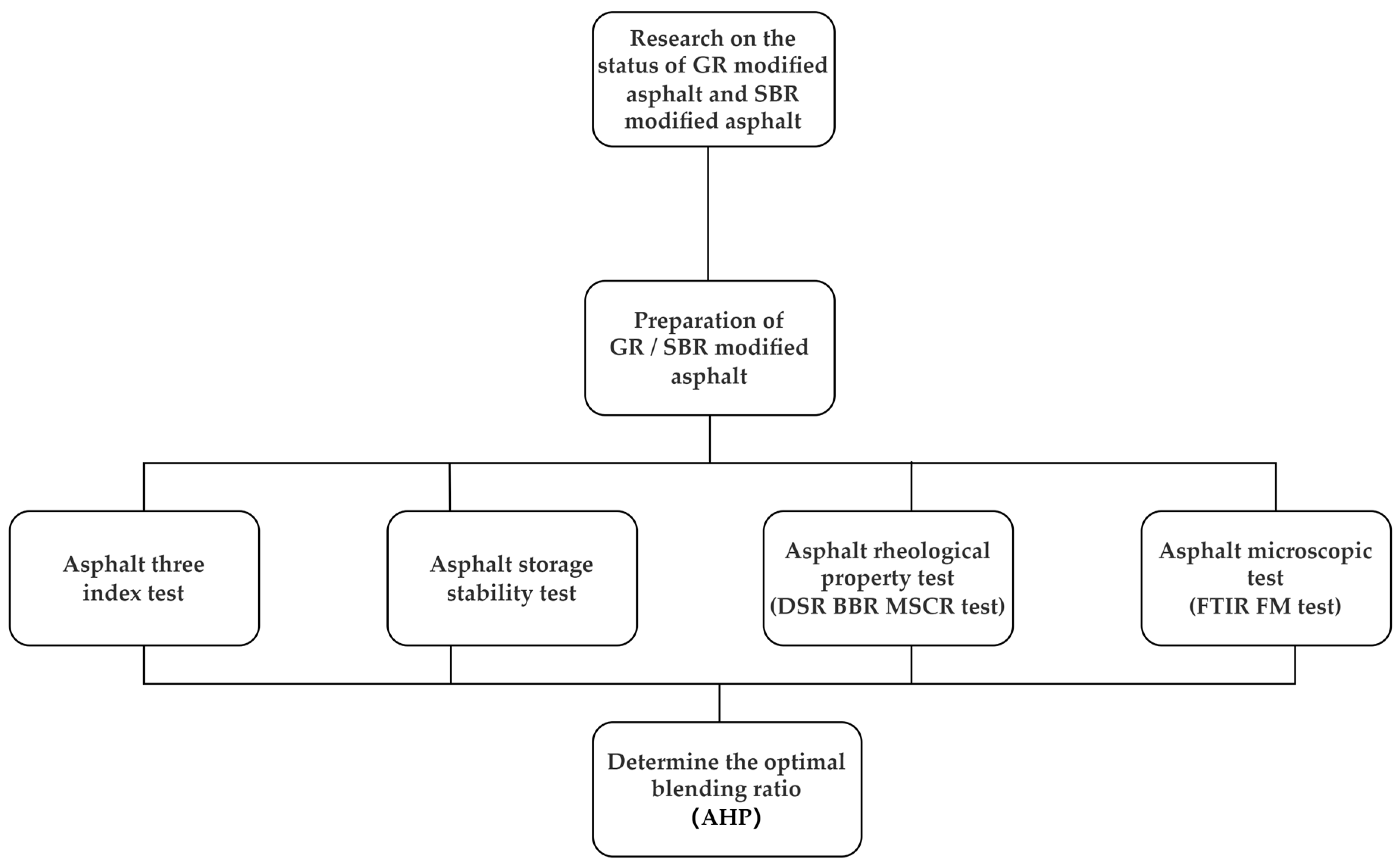
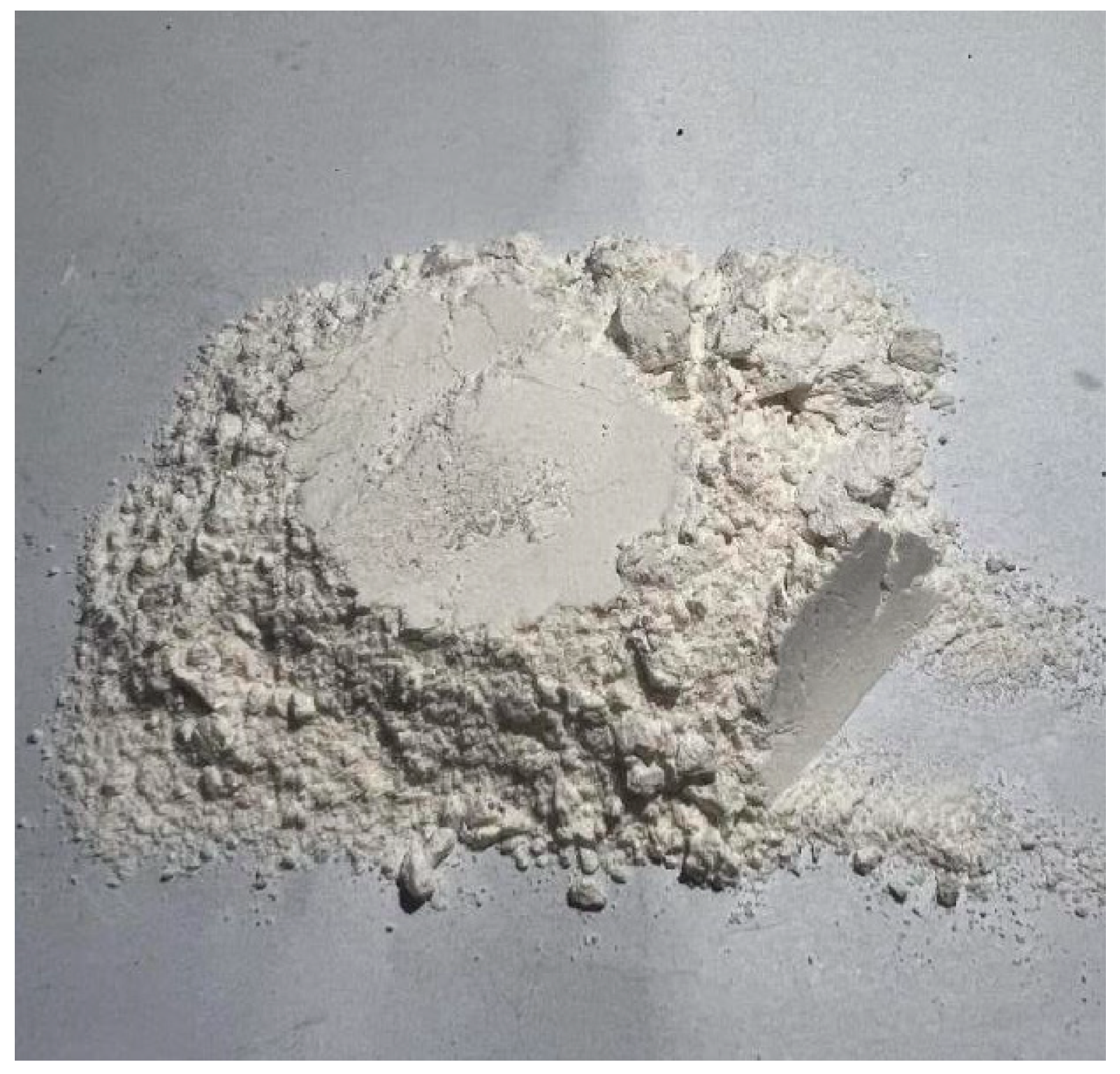

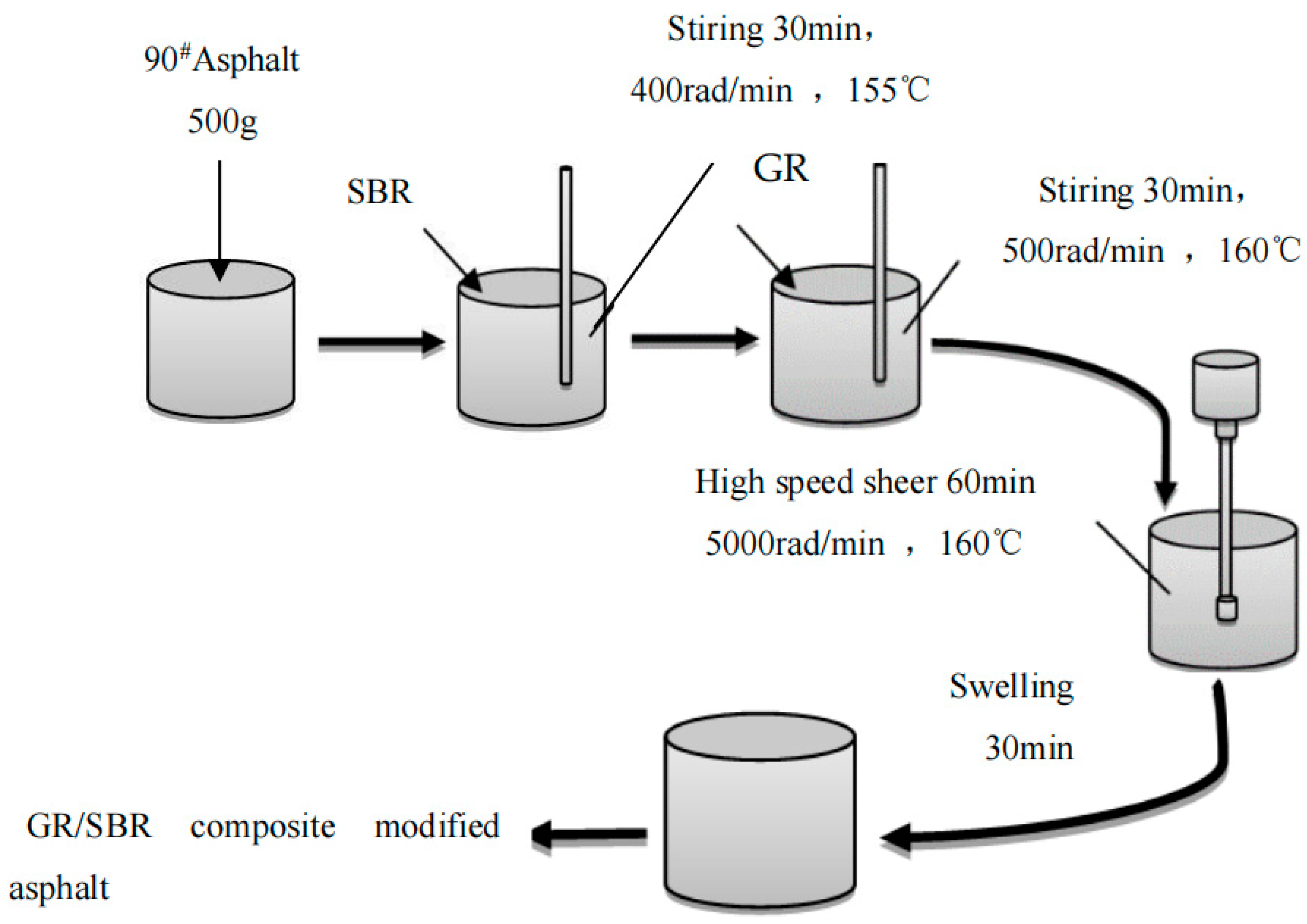
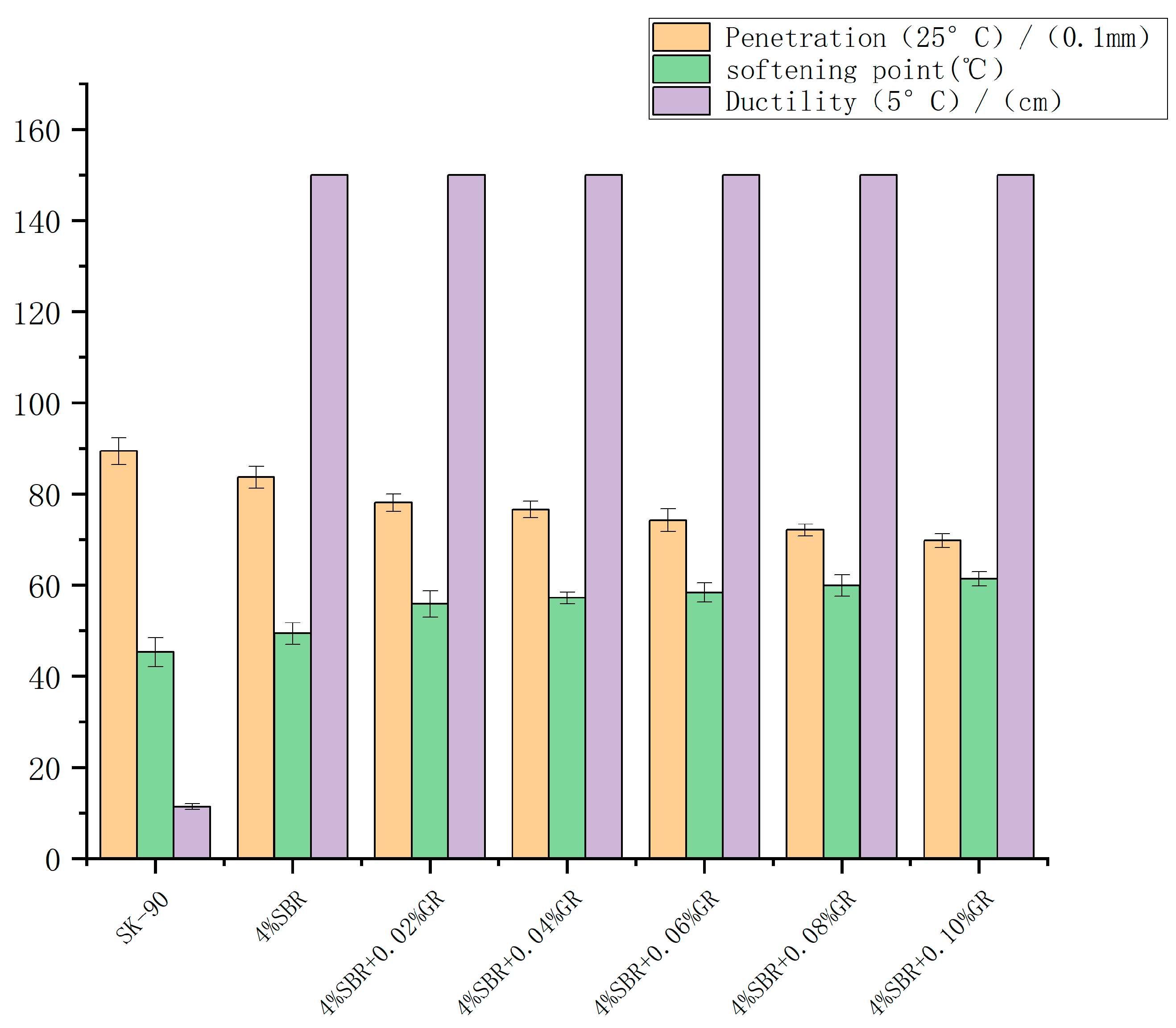




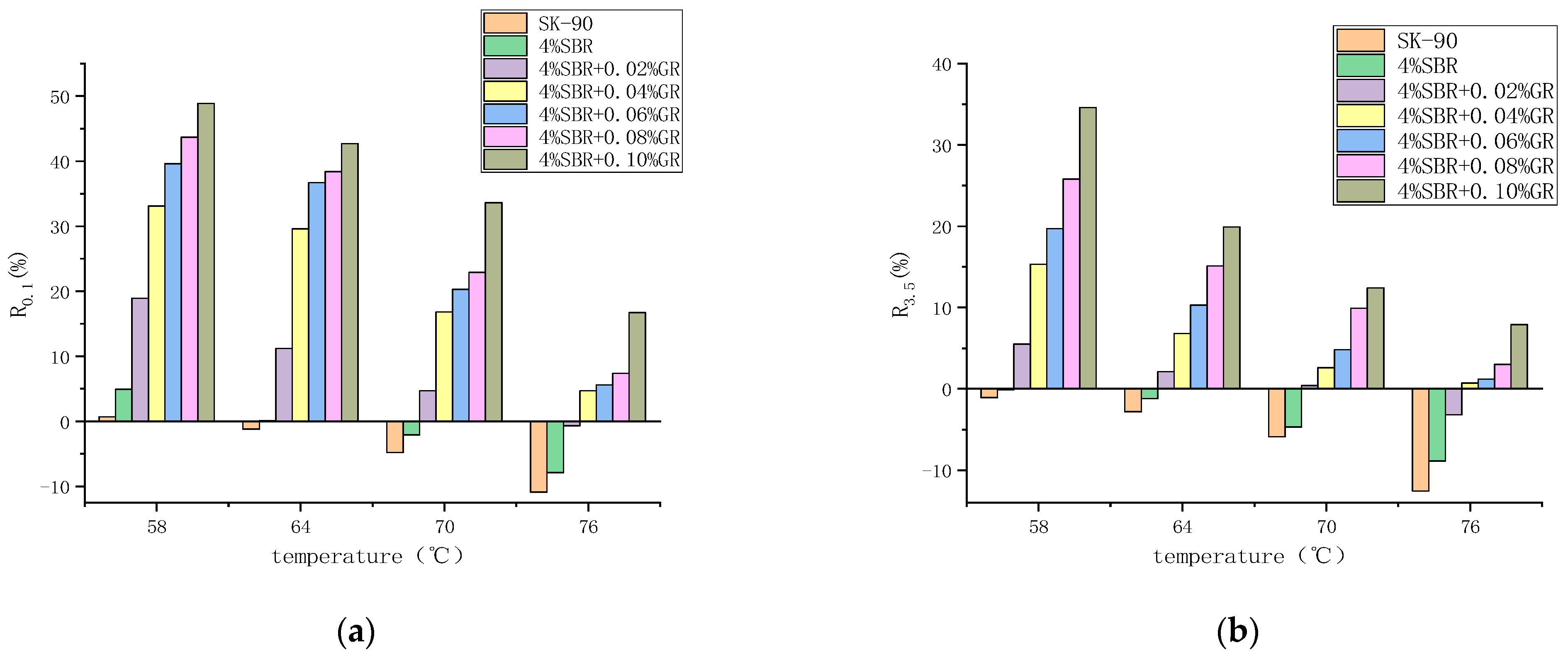
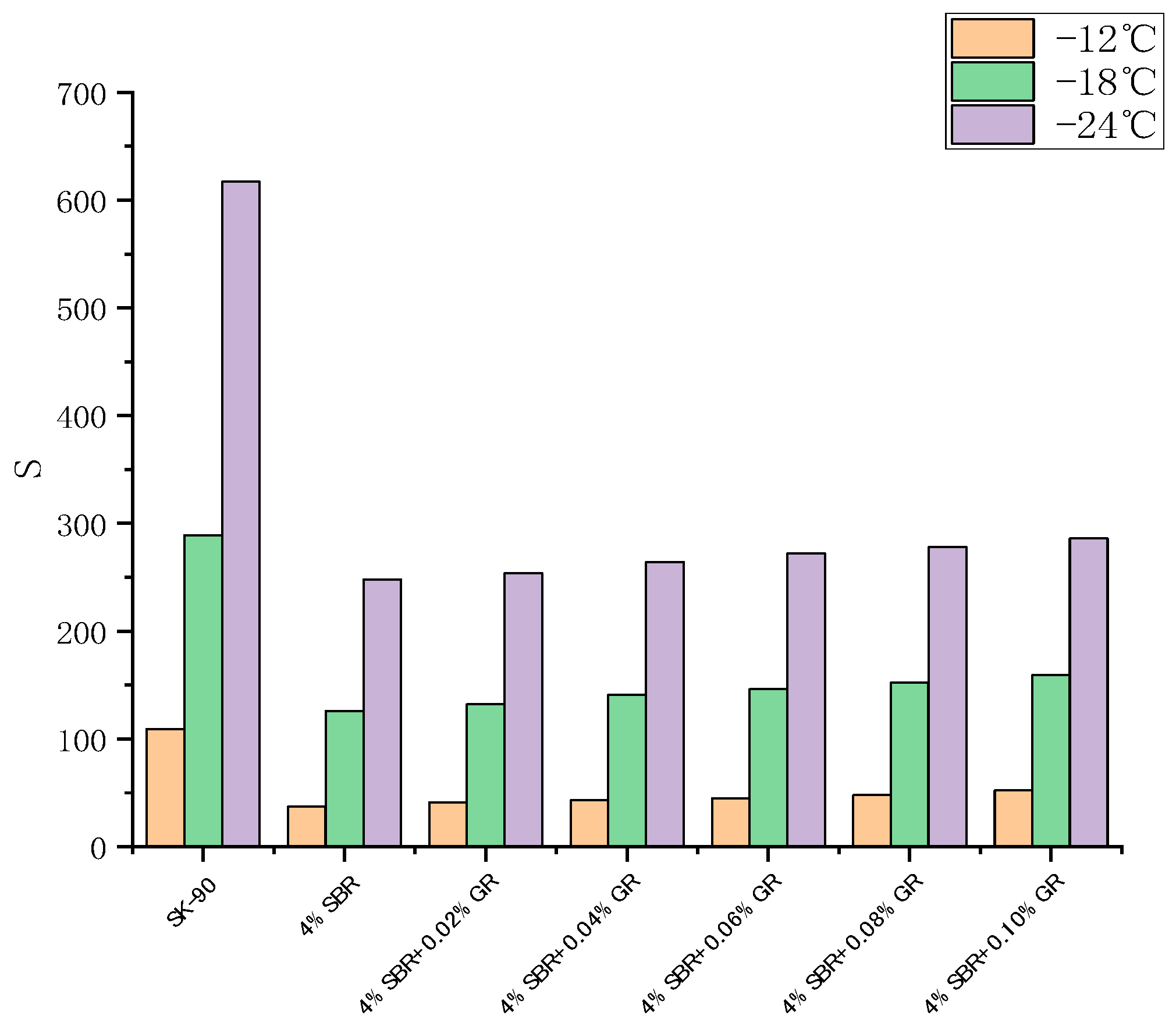




| Test Index | Test Result | Test Requirement |
|---|---|---|
| Penetration (25 °C)/(0.1 mm) | 89.4 | 80–100 |
| Softening Point/°C | 45.3 | ≥45 |
| Ductility (5 °C/cm) | 11.5 | - |
| Brookfield Viscosity (60 °C/Pa·s) | 178.4 | ≥160 |
| Test Index | Unit | Test Result |
|---|---|---|
| Morphology | - | white powder |
| Particle-size | Mesh | ≤40 |
| Filling oil content | % | 27.5 |
| Bound styrene content | % | 23.5 |
| Tensile strength | MPa | 28.5 |
| Tensile elongation | % | 410 |
| Molecular weight | thousand | 20–30 |
| Test Index | Unit | Test Result |
|---|---|---|
| Morphology | - | Black gray powder |
| Water content | % | ≤2 |
| Carbon content | % | ≥99 |
| Bulk density | g/ml | 0.01–0.02 |
| Grain size | μm | 5–8 |
| Types of Asphalt | Upper Softening Point | Bottom Softening Point | Softening Point Difference |
|---|---|---|---|
| 4% SBR | 52.1 | 49.2 | 2.9 |
| 4% SBR + 0.02% GR | 57.0 | 55.2 | 1.8 |
| 4% SBR + 0.04% GR | 58.3 | 56.9 | 1.4 |
| 4% SBR + 0.06% GR | 59.8 | 58.2 | 1.6 |
| 4% SBR + 0.08% GR | 61.1 | 59.2 | 1.9 |
| 4% SBR + 0.1% GR | 63.2 | 60.8 | 2.4 |
| GR Content (%) | 58 °C | 64 °C | 70 °C | 76 °C |
|---|---|---|---|---|
| 0 | 4.281 | 2.021 | 1.017 | 0.473 |
| 0.02 | 5.792 | 2.565 | 1.453 | 0.664 |
| 0.04 | 7.535 | 3.362 | 1.716 | 0.912 |
| 0.06 | 8.771 | 3.794 | 2.087 | 1.068 |
| 0.08 | 9.489 | 4.027 | 2.319 | 1.187 |
| 0.10 | 10.198 | 4.196 | 2.532 | 1.265 |
| GR Content (%) | 58 °C | 64 °C | 70 °C | 76 °C |
|---|---|---|---|---|
| 0 | 4.369 | 2.062 | 1.028 | 0.476 |
| 0.02 | 5.908 | 2.631 | 1.466 | 0.671 |
| 0.04 | 7.617 | 3.643 | 1.748 | 0.925 |
| 0.06 | 8.872 | 3.872 | 2.131 | 1.087 |
| 0.08 | 9.591 | 4.154 | 2.364 | 1.205 |
| 0.10 | 10.312 | 4.301 | 2.583 | 1.289 |
| Wave Number (cm−1) | Characteristic Peak |
|---|---|
| 2923 | Asymmetric stretching vibration of methyl group C-H |
| 2853 | C-H symmetric stretching vibration of methyl group |
| 2107 | The triple bond stretching vibration of cyano (-CN) |
| 1456 | Bending vibration of C-H in hydrocarbons |
| 1377 | C-H Bending Vibration in Aromatic Compounds |
| 1264 | The bending vibration of carboxyl (C=O) |
| 810 | C-H Bending Vibration in Aromatic Compounds |
| 741 | |
| 703 |
| Grade | GR (%) |
|---|---|
| A | 0 |
| B | 0.02 |
| C | 0.04 |
| D | 0.06 |
| E | 0.08 |
| F | 0.1 |
| Mark | 0 | 6 | 7 | 8 | 9 |
|---|---|---|---|---|---|
| G*/sinδ (64 °C)/KPa | <2 | 2–2.5 | 2.5–3 | 3–4 | >4 |
| k (MPa) | >450 | 400–450 | 350–400 | 300–350 | <300 |
| Penetration index PI | <−0.9 | −0.9–0.7 | −0.7–0.5 | −0.5–0.3 | >−0.3 |
| Residual penetration ratio (25 °C)/% | <65 | 65–70 | 70–75 | 75–80 | >80 |
| The softening point difference of asphalt after segregation experiment (25 °C) | >3 | 2.5–3.0 | 2.0–2.5 | 1.5–2.0 | <1.5 |
| Asphalt Type | A | B | C | D | E | F |
|---|---|---|---|---|---|---|
| G*/sinδ (64 °C)/KPa | 2.062 | 2.631 | 3.643 | 3.872 | 4.154 | 4.301 |
| k (MPa) | 300.06 | 338.46 | 371.05 | 394.59 | 410.81 | 441.67 |
| Penetration index PI | −0.73 | −0.41 | −0.29 | −0.37 | −0.49 | −0.56 |
| Residual penetration ratio (25 °C)/% | 71.4 | 76.8 | 81.2 | 75.6 | 72.9 | 67.5 |
| The softening point difference of asphalt after segregation experiment (25 °C) | 2.9 | 1.8 | 1.4 | 1.6 | 1.9 | 2.4 |
| Asphalt Type | A | B | C | D | E | F |
|---|---|---|---|---|---|---|
| G*/sinδ (64 °C)/KPa | 6 | 7 | 8 | 8 | 9 | 9 |
| k (MPa) | 8 | 8 | 7 | 7 | 6 | 6 |
| Penetration index PI | 6 | 8 | 9 | 8 | 8 | 7 |
| Residual penetration ratio (25 °C)/% | 7 | 8 | 9 | 8 | 7 | 6 |
| The softening point difference of asphalt after segregation experiment (25 °C) | 6 | 8 | 9 | 8 | 8 | 7 |
| Importance (ri vs. rj) | Judgement Matrix Scale rij (5/5-9/1 Scale) |
|---|---|
| Equally important (level 0) | 5/5 = 1 |
| Slightly important (Level 1) | 6/4 = 1.5 |
| Important (Level 2) | 7/3 = 2.33 |
| Very important (Level 3) | 8/2 = 4 |
| Absolutely important (Level 4) | 9/1 = 9 |
| Intermediate state (-) | 5.5/4.5 = 1.222 6.5/3.5 = 1.875 7.5/2.5 = 5 8.5/1.5 = 5.667 |
| Index | High Temperature Performance | Low Temperature Performance | Aging Resistance | Temperature Susceptibility | Storage Stability |
|---|---|---|---|---|---|
| High temperature performance | 1 | Importance of high temperature performance/low temperature | Importance of high temperature performance/aging resistance | Importance of high temperature performance /temperature susceptibility | Importance of high temperature performance/Storage stability |
| Low temperature performance | 1 | Importance of low temperature performance /aging resistance | Importance of low temperature performance /temperature susceptibility | Importance of low temperature performance /Storage stability | |
| Aging resistance | 1 | Importance of temperature susceptibility/Storage stability | Importance of aging resistance/Storage stability | ||
| Temperature susceptibility | 1 | Importance of temperature susceptibility/Storage stability | |||
| Storage stability | 1 |
| Climate Zoning | High Temperature Grade | Low Temperature Grade | Temperature Difference Grade | Ultraviolet Radiation Intensity | Coupling Grade of High Temperature and Ultraviolet Radiation Intensity |
|---|---|---|---|---|---|
| 2-1 partition | 2 | 1 | 1 | 2 | 2 |
| 2-2 partition | 2 | 2 | 2 | 3 | 3 |
| n Matrix | 3 | 4 | 5 | 6 | 7 |
|---|---|---|---|---|---|
| RI | 0.52 | 0.89 | 1.12 | 1.26 | 1.36 |
| Climate Zoning | High Temperature Performance | Low Temperature Performance | Aging Resistance | Temperature Susceptibility | Storage Stability |
|---|---|---|---|---|---|
| 2-1 | 0.410 | 0.513 | 0.479 | 0.445 | 0.375 |
| 2-2 | 0.511 | 0.511 | 0.340 | 0.474 | 0.372 |
| Climate Zoning | A | B | C | D | E | F |
|---|---|---|---|---|---|---|
| 2-1 | 14.803 | 17.366 | 18.562 | 17.263 | 16.715 | 15.416 |
| 2-2 | 14.744 | 17.153 | 18.339 | 17.153 | 16.679 | 15.493 |
Disclaimer/Publisher’s Note: The statements, opinions and data contained in all publications are solely those of the individual author(s) and contributor(s) and not of MDPI and/or the editor(s). MDPI and/or the editor(s) disclaim responsibility for any injury to people or property resulting from any ideas, methods, instructions or products referred to in the content. |
© 2023 by the authors. Licensee MDPI, Basel, Switzerland. This article is an open access article distributed under the terms and conditions of the Creative Commons Attribution (CC BY) license (https://creativecommons.org/licenses/by/4.0/).
Share and Cite
Wang, L.; Liang, F.; Li, Z.; Zhao, Q. Investigation on the Rheological Properties and Microscopic Characteristics of Graphene and SBR Composite Modified Asphalt. Coatings 2023, 13, 1279. https://doi.org/10.3390/coatings13071279
Wang L, Liang F, Li Z, Zhao Q. Investigation on the Rheological Properties and Microscopic Characteristics of Graphene and SBR Composite Modified Asphalt. Coatings. 2023; 13(7):1279. https://doi.org/10.3390/coatings13071279
Chicago/Turabian StyleWang, Lijun, Fengxiang Liang, Zixia Li, and Qiang Zhao. 2023. "Investigation on the Rheological Properties and Microscopic Characteristics of Graphene and SBR Composite Modified Asphalt" Coatings 13, no. 7: 1279. https://doi.org/10.3390/coatings13071279
APA StyleWang, L., Liang, F., Li, Z., & Zhao, Q. (2023). Investigation on the Rheological Properties and Microscopic Characteristics of Graphene and SBR Composite Modified Asphalt. Coatings, 13(7), 1279. https://doi.org/10.3390/coatings13071279





